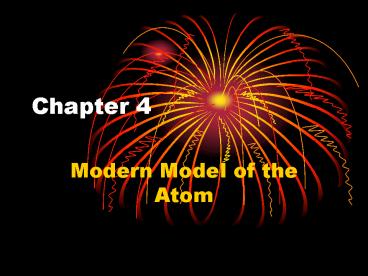Modern Model of the Atom - PowerPoint PPT Presentation
1 / 29
Title:
Modern Model of the Atom
Description:
... form of energy that exhibits wavelike behavior as it travels through space ... Wavelength (?) the distance between corresponding points on adjacent waves. ... – PowerPoint PPT presentation
Number of Views:63
Avg rating:3.0/5.0
Title: Modern Model of the Atom
1
Chapter 4
- Modern Model of the Atom
2
- Electromagnetic Radiation form of energy that
exhibits wavelike behavior as it travels through
space - Electromagnetic Spectrum all the forms of
electromagnetic radiation
3
(No Transcript)
4
Question of the Day
- Why do our bodies tan?
5
- Wavelength (?) the distance between
corresponding points on adjacent waves. - Frequency (v) defined as the number of waves
that pass a given point in a specific time
6
Photoelectric Effect
- Emission of electrons from a metal when light
shines on the metal - Quantum the minimum quantity of energy that can
be lost or gained by an atom.
7
- Photon a particle of electromagnetic radiation
having zero mass and carrying a quantum of energy.
8
(No Transcript)
9
(No Transcript)
10
Bohr Model of the Atom
- Electrons can only travel in special orbits at
certain discrete, set distances from the nucleus
with specific energies - Electrons do not continuously lose energy as they
travel, they only gain/lose energy by jumping
from one allowed orbital to another.
11
- In the Bohr model, only certain orbits with
certain radii are allowed orbits in between
simply do not exist. - When the electron is in one of these orbits, the
atom has a fixed energy. - The lowest energy state is closest to the
nucleus. - This orbit is separated from the nucleus by a
large empty space where the electron simply
cannot exist - The energy of the electron is higher when it is
in orbits that are farther from the nucleus
12
Explaining Spectral Lines
- An electron can move to a higher energy orbit by
gaining an amount of energy equal to the distance
between the two orbits. - When the atom falls back from the excited state,
the electron drops down to the lower energy
orbit. In the process, light is emitted with an
energy equal to the difference between the orbits.
13
Homework
- Page 97 1-5
- Due October 15
14
Bohrs Model
- In Bohrs model, electrons can jump from one
allowed energy level to another but they can
never have any energy between the allowed ones.
15
(No Transcript)
16
- Orbits (shells) get larger as the quantum number
increases - Electrons in the n 1 orbit have the lowest
energy - Each shell can hold a maximum of 2n2 electrons
- When an atom is being built, innermost shell is
filled first. Aufbau Principle
17
(No Transcript)
18
Valence Shell
- The outermost occupied shell of an atom is called
the valence shell
19
Valence Shell
20
Shortcut Method
- For the representative elements, the number of
electrons in the valence shell of an atom is
equal to the roman-numeral group number.
21
(No Transcript)
22
(No Transcript)
23
- s block is 2 elements wide because an s subshell
can hold a maximum of 2 electrons - p block is 6 elements wide because..
- d block is 10 elements wide
24
- The period (row) number tells you which shell (n)
is currently being filled unless you are in the d
or f block. - In the d block, the value of n for the d subshell
being filled is one less than the period number - In the f block, the value is two less than the
period number
25
Heisenberg Uncertainty Principle
- Electrons are detected by their interaction with
photons - Any attempt to locate an electron with a photon
knocks the electron off its course - As a result, there is always a basic uncertainty
in trying to locate an electron
26
Heisenberg
- States that it is impossible to determine
simultaneously both the position and velocity of
an electron.
27
(No Transcript)
28
Orbitals
- Three dimensional areas around the nucleus that
indicate the probable location of an electron
29
(No Transcript)































